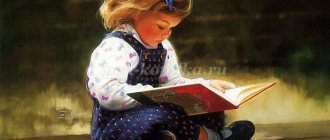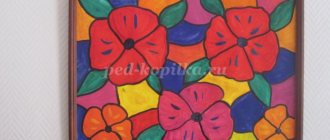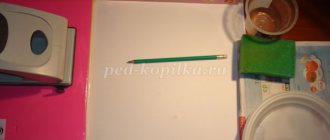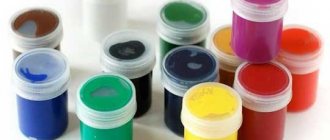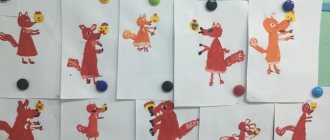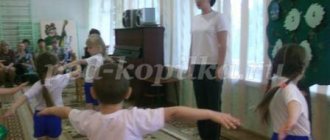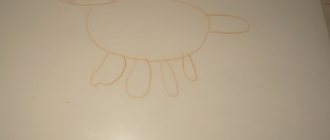Story drawing lesson
Educator: Children, let us also become artists. Let's close our eyes and say the magic words - "Cribly-crably-boom."Educator: Well, now you and I have turned into real artists, but what are we going to paint, what landscape?
Guys, I suggest you draw such a wonderful landscape (I show a sample). But first, let's remember what a real artist should be able to do?
The artist must hold the brush correctly (by the upper part of the metal skirt), be able to use paints (rinse the brush after using one paint, and only then put another on the brush).
(Demonstration of a picture depicting winter, accompanied by a literary word:
It's winter on our street
Everything was covered with white snow, Houses, trees and bushes
Look how good they are.) I draw children's attention to trees in winter. - Guys, look at how beautiful the trees are in winter... The trunk of the trees is brown, and the branches are white, all covered in snow. — What kind of paint do we need to paint the tree? — What paint should we take to paint snow? - Well done!
- Now let's see how and what we will draw. — First we need to draw a tree trunk, and then a snow cap. Demonstration of the image method: In order to start drawing, take a brush in your hand with three fingers: thumb, index and middle (pinch), by the upper part of the skirt - like this. Dip the brush into a jar of water, and wipe off excess water from the brush on the edge of the jar. Then we dip our brush into a jar of brown paint. We bring our brush to the bottom of the sheet of paper and draw a straight line from bottom to top, but not to the end of the sheet. Then from top to bottom we draw a continuation of our trunk, like this, and paint over the gap between our lines - this will be the trunk. From the trunk we will draw branches. Using the tip of the brush, we draw a line from the top of our trunk to the right and upward, then branch it. Like this! We draw in the same way on the left side.
To paint snow, we need to wash our brush, otherwise the snow will be dirty. To do this, we bathe our brush in a jar of clean water. After we have washed the brush, we wipe off excess water from it on the edge of the jar. Dip a clean brush into a jar of white paint. To make beautiful white fluffy snow, we use a brush to make an imprint on the top of our trunk. We apply the soft bristles of the brush to the sheet and immediately remove it - look how beautiful it turned out, if you do it right, you will succeed too! You need to put a lot of imprints to make the tree beautiful. We will also cover the ground with snow (I make prints) - like this! In the center of the tree we can draw a hollow in black. Our hollow is like an elongated leaf, like this. In the upper right corner we can draw a sun with you. We draw it by rotating the brush around its own axis, here. Guys, what else can we draw on our landscape?
Certainly! Bullfinch! We start drawing our bullfinch from the head, place it on this branch, put black paint on a brush, draw a circle with the tip of the brush and draw a beak near our circle, like this. Next, we begin to draw the back of the bullfinch - to do this, we draw a curved line from the bottom of the head; at the end of this line we draw two thin stripes, this will be our tail. All we have to do is draw the chest of the bullfinch. Our breast is drawn like a droplet, like this.
We will complement our landscape with snowfall, and we will paint the snowfall with white gouache, with the tip of a brush, leaving dots like these on the sheet, look.
— Guys, after you paint your landscapes, don’t forget to wash your brushes, otherwise they will be offended. To do this, we need to bathe the brush in a jar of water, and then dry it by dipping it on a napkin. - Before we start drawing, let's stretch our fingers! Finger gymnastics “Snowball”
One, two, three, four, (Bend your fingers one at a time)
You and I made a snowball,
(“We sculpt” with both hands) Round, strong, (We draw a circle with our hands)
And completely, completely unsweetened. (We shake our fingers) - Well done! Now we sit down at the tables and start drawing.
(While the children are working, the teacher helps children who are having difficulty, draws attention to the fact that the missing colors can be mixed on the palette themselves, we recall drawing techniques. While drawing, the teacher pays attention to the children’s posture)
On the topic: methodological developments, presentations and notes
Plan of drawing notes (preparatory group) on the topic: “Winter Landscape” using the non-traditional “Imprint” technique (drawing with vegetables).
Topic: “The Adventures of the Hedgehog” (dry brush, combing paint) Visual tasks: - continue to learn how to use a combination of colors to create an image of autumn - continue to learn by mixing.
summary of a drawing lesson in the junior group “Beasts in the Forest.”
Notes on drawing in the senior group. Non-traditional drawing technique “Printing with leaves.” Theme "Autumn Forest".
Program content. Expand children's knowledge about the variety of mushrooms. Learn to draw mushrooms of different shapes, structures and colors. Practice drawing a forest clearing. Strengthen the ability to draw with paints and...
Notes on drawing in the junior group “Snowy meadow for a bunny” Drawing using an unconventional technique of drawing with a finger and a cotton swab. Purpose: To consolidate drawing skills.
The purpose of the project: to conduct entertaining classes in painting with paints. Identification and development of creative abilities in children of the older group by conducting entertaining classes in painting with paints. To introduce.
Source
On the topic: methodological developments, presentations and notes
Summary of a lesson in story drawing for children of the senior group “The Little Humpbacked Horse.” Type of activity: story drawing. Age group: senior group. Topic: “The Little Humpbacked Horse.” Program.
Summary of a lesson in decorative drawing for children of the senior group “Elegant young lady” (based on the Dymkovo toy) Program objectives: continue to teach children how to decorate with decorative elements.
laquo;Elegant young lady” (based on the Dymkovo toy).
OD summary on decorative drawing for the senior group “Elegant young lady” (based on the Dymkovo toy).
Summary of a lesson on speech development for children of the senior group "Compiling a story based on a series of plot paintings "Girl Masha and doll Natasha."
Summary of a lesson on learning to draw for children of the senior group “Spruce Branch”. Visual tasks: - Learn to convey the image of a spruce branch, consisting of one main branch and several.
Source
GCD summary. Story drawing “Our group”
Tyutyunova Daria
GCD summary. Story drawing “Our group”
Abstract of GCD . Story drawing " OUR GROUP "
Create conditions for reflecting in the drawing impressions of the life of children in kindergarten, in your group . Learn to draw simple plots , conveying the movements, interactions and relationships of children to each other. Involve children in collective discussion of a common plan. Develop a sense of color and composition. Cultivate friendliness, maintain interest in cooperation and co-creation with peers and adults; accuracy. Arouse interest in the work and the desire to create a homemade album!
Preview:
Municipal budgetary preschool educational institution "Kindergarten No. 140 of a combined type" of the Volga region of Kazan
Summary of an open lesson on plot drawing
Goal: to evoke in children an emotional response to the artistic image of a winter landscape, associations with their own experience of winter nature.
Objectives: To teach children to independently come up with the composition of a drawing, highlighting the far and near plan of the landscape; enrich children's speech with emotionally charged vocabulary and aesthetic terms. To develop children's interest in unconventional techniques for depicting snow, to help them feel the beauty of winter nature through music, painting, and poetry;
Features of teaching drawing to older preschoolers
At this age, children learn to find and convey in drawings the similarities and differences of homogeneous objects. So, in the first quarter, they draw fruits, vegetables, and flowers from life, conveying their characteristic features (for example, 2 apples of different varieties, differing in shape and color, beets and turnips, which have a round shape common to vegetables).
The preparatory group completes the training of preschoolers in fine art skills. Children should come to school with basic skills in drawing objects from life and from memory, the ability to see a variety of shapes, colors, and the position of objects in space in the life around them.
Six-year-old children have fairly well developed analytical thinking. They can highlight both common features inherent in objects of the same type, and individual characteristics that distinguish one object from another.
The main goal of plot drawing is to teach a child to convey his impressions of the surrounding reality.
It is known that all surrounding objects are in a certain connection with each other. The attitude towards any object or phenomenon largely depends on the understanding of this particular connection.
The ability to establish semantic connections between various objects and phenomena develops gradually in the child. Therefore, plot drawing for educational purposes is introduced no earlier than in the middle group, and initially as an image of 2-3 objects located nearby. Naturally, children should know the techniques for depicting objects that are the main characters in the plot, otherwise difficulties in depicting unfamiliar objects will distract them from completing the main task. However, plot drawing should not be limited to depicting only those objects that children have already depicted. The child must be able to draw the main thing in the plot, and he completes all the details as he wishes.
The ability to highlight the main thing in a plot is associated with the development of perceptions and analytical-synthetic thinking. In a small child they are still too superficial; he first of all perceives what is directly accessible to sight, touch, and hearing, and often recognizes an object by some insignificant details that he remembers. In the same way, a child perceives and conveys the plot in a drawing. Highlighting the main thing, understanding the relationships and connections of plot objects are quite difficult tasks for a preschooler. They can be solved by children of the older group.
In plot drawing, it is important to correctly convey the proportional relationships between objects. This task is complicated by the fact that when depicting a plot, it is necessary to show not only the difference in their sizes that exists between them in life, but also the increase or decrease of objects in connection with their location in space. To do this, the child must be able to compare and contrast image objects, and see the semantic connection between them.
Solving the problem of spatial relationships between objects is very difficult for a preschooler, since he has little experience and insufficiently developed visual skills.
Children can gain ideas about the extent of space, about the horizon line connecting the earth and sky, mainly when traveling into nature (into the forest, field). But even if some of them understand the perspective changes of objects in space, it will be difficult for them to convey these changes on the plane of the sheet. What is located far away in nature should be drawn higher in the drawing, and vice versa. These features of the image of space on a plane are understandable only to an older preschooler who has experience.
So, the general objectives of teaching story drawing in kindergarten are the following:
- teach how to convey the content of a topic, highlighting the main thing in it;
- teach how to convey interactions between objects;
- teach how to correctly convey proportional relationships between objects and show their location in space.
In plot drawing, children are not tasked with showing exact proportional relationships between objects, since it is quite complex and accessible only to children of the older group.
The content of the plot drawings of children aged 5-6 years is significantly enriched due to the experience they acquire in drawing. Children include in their compositions not only objects, but also their surroundings.
The tasks of plot drawing in the senior group are as follows:
- teach the depiction of semantic connections between objects, the transfer of spatial relationships between them;
-develop compositional skills (draw on the entire sheet, drawing a horizon line);
- develop a sense of color.
The subject of plot drawing in the older group is determined, first of all, by the impressions that the child receives from observing the surrounding reality. For children of this age, the content of each topic should be specifically defined. They should not be given general themes, such as “Holidays.” They may draw something unrelated to the topic or set themselves a daunting task that is not suited to their skills, such as drawing a demonstration
Decorative drawing, like all types of fine arts, develops a child’s sense of beauty. Works of folk decorative art are close to children due to their colorfulness and simplicity of composition.
By introducing children to works of decorative art from various regions and nationalities of our country, the teacher must instill in the children a love for the Motherland and respect for the work of the people who create this beauty.
A teacher teaching children decorative drawing faces the following tasks:
- develop a sense of composition in connection with the construction of patterns on various forms;
- develop a sense of color;
-develop the ability to distinguish between styles in the decorative arts and use their individual elements in your creativity;
— improve technical skills in drawing with a brush and pencil.
When teaching children decorative drawing, the teacher must develop in them the ability to see the relationship between all components of the pattern, color, composition, and elements of form.
The child must feel and understand how the ornament decorating it changes depending on the purpose and shape of the object. From here he learns the meaning, the appropriateness of design, the connection between form and content.
Children, getting acquainted with decorative drawing, must learn to clearly imagine what rhythm and symmetry are, without which decorative art cannot exist.
In decorative painting, developing a sense of color stands out as an important task. Color in a painted ornament is closely related to composition; in a pattern they are inseparable from each other.
Naturally, preschool children cannot master all the possibilities of color combinations, although the sense of color begins to develop even in pre-preschool age.
The task of using color in decorative painting becomes more complex in each group, starting with the brightest, most contrasting combinations and ending with shades of warm and cool colors in different combinations.
Children of the fifth year of life can be given more complex tasks in decorative drawing, since the level of development of aesthetic feelings at this age is much higher.
Children need to be taught:
- arrange the pattern symmetrically depending on the shape of the sheet of paper or three-dimensional object;
- use a variety of straight, rounded lines and shapes, plant elements in the pattern;
- find beautiful combinations of colors depending on the background;
- skillfully use a brush (paint with the end, the whole brush, move it freely in different directions). [11;p.83].
1.4. Analysis of visual arts programs in kindergarten
There are now many programs for visual arts in kindergarten. Let's analyze one of them in detail:
G.S. Shvaiko “Program for visual activities in kindergarten”
The goal of the program is to develop artistic and creative abilities in preschool children
General pedagogical objectives of the program:
1.Develop children's creative abilities through visual arts. To this end:
— to form sensory abilities;
- to form the perception and imagination of an object;
-form generalized ideas about homogeneous objects and methods of depiction;
- to develop the ability to imagine based on accumulated knowledge and imagination for independent work.
2.Develop children’s cognitive activity
3. Foster cultural activities, develop cooperation skills. For this:
- create a favorable emotional climate in the group;
— create conditions for teamwork;
- instill in children an interest in each other’s work.
The program consists of cycles:
- Oval and round objects;
- Trees;
- Items of square and rectangular shape;
- Animals;
- Winter. Christmas tree;
- Cycle – man;
- Arranging objects and circles.
Objectives of teaching children to draw in the 1st cycle of classes:
Teach children:
1. Depict oval and round objects
2. Form compositional skills:
- place objects on the entire plane of a sheet of paper
-implement in the drawing one of the two proposed options for the location of characters: opposite each other or behind each other
3. Teach children to convey simple movements of characters in drawing
4. Develop imagination and form a generalized idea of objects of a similar shape, learn to solve creative problems based on them (“Complete the drawing of whoever you want”, “Take a picture of a riddle and draw the answer”)
5. Cultivate in children an interest in using their visual works for play.
Objectives of teaching children to draw 2 cycles of lessons:
1. To form in children a generalized idea of a tree and how to depict it
2. To form an idea of the changes in the appearance of trees in different periods of autumn, to teach how to reflect these changes in subject and subject drawings
3. Learn to convey significant differences in the size of objects and insignificant ones in plot drawings
4. Develop children’s creative abilities, teach how to make additions to drawings, expand their content based on existing ideas and previously mastered skills, independently choose the content of a drawing on a proposed topic
5. To develop the skills of drawing thin lines, inclined lines with the end of the brush with their gradual lengthening; reinforce the vertical stroke technique
Objectives of teaching children to draw 3 cycles of lessons:
1. Learn to distinguish and depict rectangular and square objects in drawings
2. Help children master form-building movements in drawing to depict square and rectangular objects and objects consisting of rectangular and square-shaped parts
3. Strengthen the skills of painting images with pencils and paints in one direction, without going beyond the outline, develop the ability to distinguish between methods of painting with paints and pencils (tear-off, continuous)
4. To develop the ability to distinguish and use two shades of the same color in visual works
5. Encourage children to make additions to the drawings that enrich their content (“Doll House”, etc.)
Objectives of teaching children to draw 4 cycles of lessons:
- Help you master the ovoid shape in drawing animals
- To develop the ability to notice the characteristic features of different animals and reflect them in a drawing (“Hedgehog”, “Bear”, “Bunny”)
- Learn to give expressiveness to images through the depiction of simple movements and their pose (“Bunny”, “Toy Bear”, “Squirrel with Fungus”)
Objectives of teaching children to draw in the 5th cycle of lessons:
- Develop independence in the selection of various details when depicting individual objects, content for plot drawings, visual material (“Snowman”, “We made different snowmen”)
- Teach ways to depict triangular shapes in drawing
- Learn to use color as a means of expression (“The Snow Maiden’s House…”, “Decorated Christmas Tree”)
